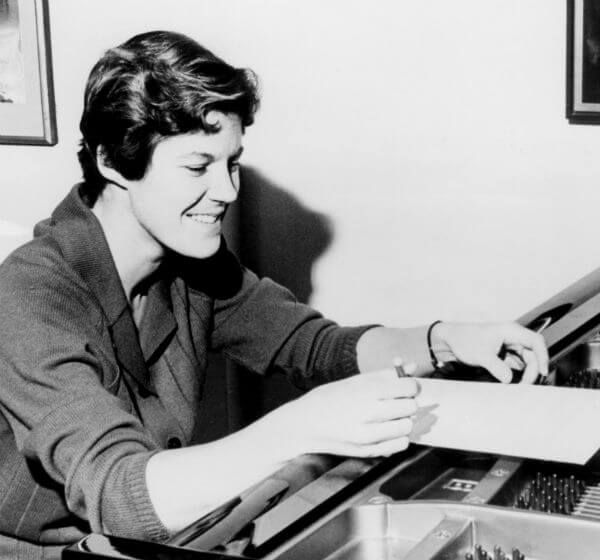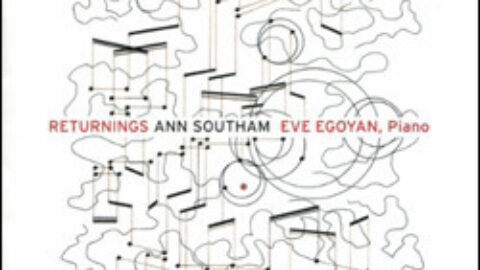 Ann Southam, who passed away at the age of 73 in 2010, was one of Canada’s foremost composers. Before becoming a composer, she studied visual art (she designed the cover art for this album). She then spent years working primarily with electroacoustic music, and many years working with New Dance Group of Canada (later renamed Toronto Dance Theater). Her musical works blend seamlessly the techniques of 12-tone writing with lush romantic harmonies and a sparse sort of minimalism. Southam was always searching for a simpler was of writing, of “seeing how eloquent I can be in as simple a ways as possible” (from the album’s liner notes, which are in both English and French). Judging by this CD, she was indeed successful in portraying great eloquence without the “billions of notes” she sought to avoid.
Ann Southam, who passed away at the age of 73 in 2010, was one of Canada’s foremost composers. Before becoming a composer, she studied visual art (she designed the cover art for this album). She then spent years working primarily with electroacoustic music, and many years working with New Dance Group of Canada (later renamed Toronto Dance Theater). Her musical works blend seamlessly the techniques of 12-tone writing with lush romantic harmonies and a sparse sort of minimalism. Southam was always searching for a simpler was of writing, of “seeing how eloquent I can be in as simple a ways as possible” (from the album’s liner notes, which are in both English and French). Judging by this CD, she was indeed successful in portraying great eloquence without the “billions of notes” she sought to avoid.

The first time I listened to Eve Egoyan’s new CD of Ann Southam’s last works, Returnings, I was fascinated by how the album fits together. It is almost as through the pieces were meant to be performed one after the other, running together into a giant four-movement piece. Each of the pieces felt well constructed, the album as a whole magnified this sense of wholeness. The disk contains a world premiere performance of Returnings II: A Meditation, along with Toronto premiere performances of Returnings I and Qualities of Consonance.
Southam’s pieces each make great use of the harmonic language more commonly associated with tonal composition and the repetitions of minimalism. These compositional devices serve as a bit of a disguise for the serial nature of the 12-tone materials. Each of the four pieces on this disk contain a complete 12-tone row, although a casual listener would never notice them. In essence, Southam manages to unite the tonal and atonal musical languages, in the process of creating her own unique voice. While I tend to associate minimalist works (think Glass or Reich) with a “groovy” sort of feeling, Southam’s works instead use minimalism’s characteristic repetitions to emphasize emotional content—a philosophical minimalism, as it were.
 On further listening, one possible reason why the album fits together so well becomes apparent. The first time I listened to the disk, I didn’t actually notice where Returnings I ended and In Retrospect (track 2) began, because the two pieces are based on the same tone row. The first track, Returnings I, introduces itself through an incomplete row (it stops at 11 tones). The row is eventually completed about 10 minutes into In Retrospect, when we finally get the one remaining note: F-natural. Southam herself picked the order for the works on this CD, and I wonder if perhaps she grouped these pieces this way because of their relationship to one another.
On further listening, one possible reason why the album fits together so well becomes apparent. The first time I listened to the disk, I didn’t actually notice where Returnings I ended and In Retrospect (track 2) began, because the two pieces are based on the same tone row. The first track, Returnings I, introduces itself through an incomplete row (it stops at 11 tones). The row is eventually completed about 10 minutes into In Retrospect, when we finally get the one remaining note: F-natural. Southam herself picked the order for the works on this CD, and I wonder if perhaps she grouped these pieces this way because of their relationship to one another.
With the minimalistic tendencies found in Southam’s writing comes the joys of hearing a pianist sensitive to minute changes in mood. Egoyan brings out the slight changes and adds shades of pianistic color to keep the interest level high even while the notes themselves are few. Southam wrote each of these pieces especially for Egoyan, whom she collaborated with for the past decade of her life. Having worked closely with composers myself, I have a great affection for works performed by the people they were written for — there is sometimes music beyond what is on the page that is communicated between the collaborating composer and musician that gets “lost in translation” in subsequent performances. Egoyan brings a certain personal connection to these works into her performance that adds to the quiet eloquence of these works.

Eve Egoyan’s thoughtful performances of each of the works on this disk only add to the pleasure of listening to it. She shapes the sometimes very long lines with great clarity, and has a close emotional connection with the pieces, which were written with her in mind. The third work on the disk, Qualities of Consonance, stuck out from the other three works because it alone has several faster and more virtuosic sections. Egoyan pulls of the more technical passages with brilliance, without overshadowing the more sensitive sections of the work.
—
Kelsey Walsh is a pianist and currently resides in San Francisco. Follow her on twitter: @kwpianist
























